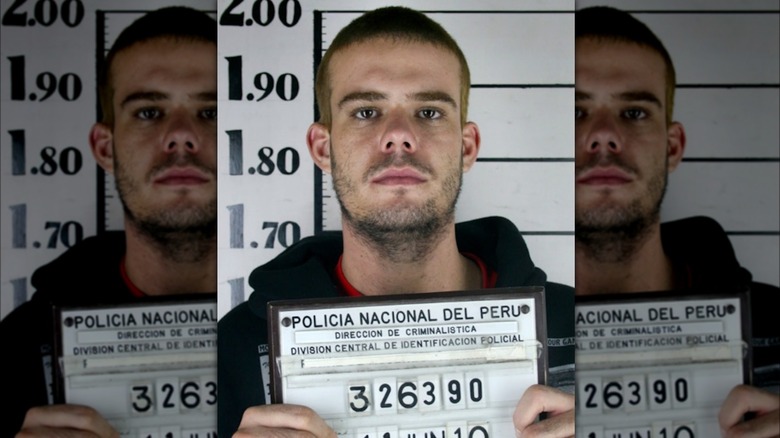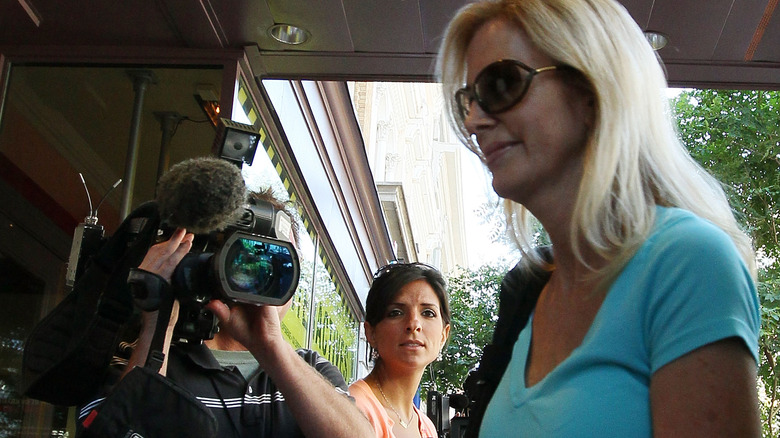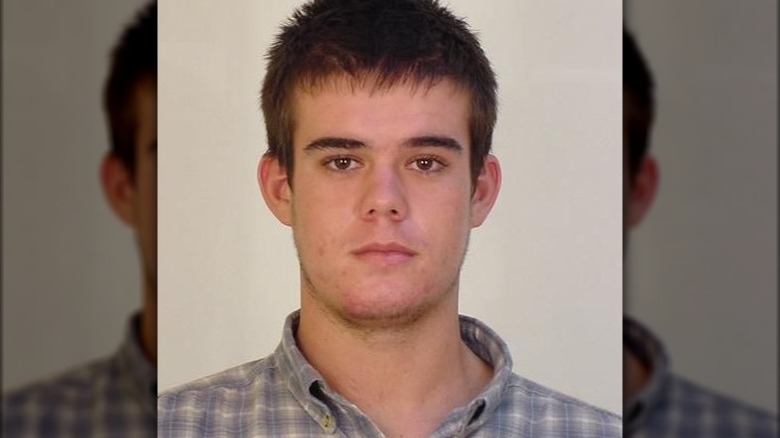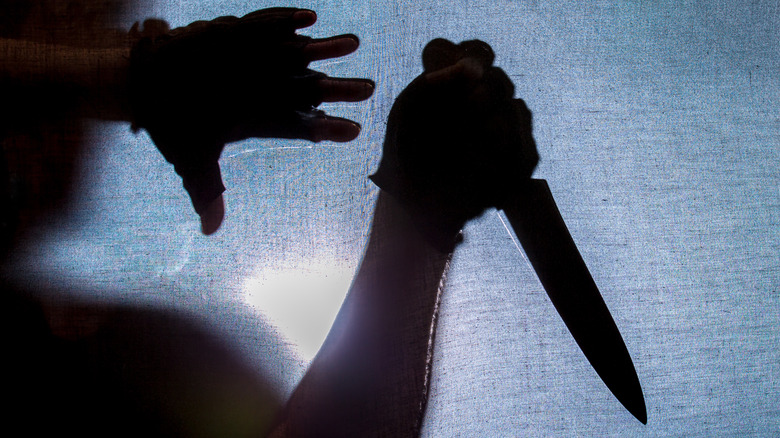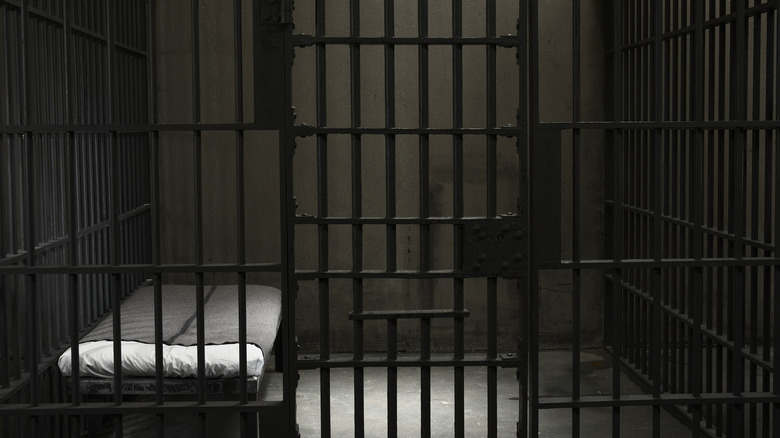The Dark Life Of Joran Van Der Sloot
In 2005, headlines across the nation were reporting on minute-by-minute developments in the investigation into the disappearance of an Alabama high school student named Natalee Holloway. Exactly what happened to Holloway remains a mystery, but she was officially declared dead in 2012. Still, her mother — who has been her relentless champion in a decades-long search for justice — hasn't stopped trying to learn her fate, and see who was responsible for her disappearance behind bars.
Fast forward to 2023, and it might seem like justice was just never going to happen. But then, one of the main suspects from the initial investigation was in headlines again, as he was being extradited from where he was being held in a Peruvian jail and sent to the U.S. The charges being filed against him weren't for murder, but instead, were for fraud and extortion. In October he pleaded guilty to those charges in a plea bargain that included his confession to killing Holloway.
Joran van der Sloot was one of three men last seen with Holloway on the night she disappeared. His story of what happened that night has changed repeatedly over the years, but a lack of evidence has meant that official charges haven't stuck. But this is actually where the story gets very, very weird, because van der Sloot has been connected with a whole slew of things, including sex trafficking, drug rings, and another murder. Here's what's known about his shady past, and what's been said about him.
His mother has spoken about his sneaky tendencies
Natalee Holloway went missing on a trip to Aruba, and almost immediately, Joran van der Sloot became a person of interest. What would ultimately unfold is a tale of a sordid life full of crimes and confessions, and according to what his mother revealed in a Dutch interview, she always knew that there was a dark side to her son.
The van der Sloot family are Dutch nationals, and in the interview obtained by ABC News, Anita van der Sloot said that although he initially denied he had anything to do with Holloway's disappearance, his story changed by the telling. He eventually said that while he had seen her that night, he wasn't responsible for her murder... although, that tale would change again, and even his mother was uncertain. "Maybe he missed his chance to become an actor," she said. "Maybe that should've been a role in his life. I really don't know. I can hardly believe that he can... fake this."
Anita also claimed that her son had mental health issues, and added that even when he was young, they had problems with him sneaking out of the house at night. They would later find out that he was spending his nights gambling at area casinos, and ultimately, gambling became a persistent theme throughout his life. That's important: Exactly five years after Holloway's disappearance, Joran met Stephany Flores in a casino and would later be convicted of her murder.
Here's what he had to say about Natalee Holloway
Joran van der Sloot was initially arrested in 2005 — along with Deepak and Satish Kalpoe — and all were released due to a lack of evidence. They were arrested again in 2007, on counts of "involvement in the voluntary manslaughter of Natalee Holloway or causing serious bodily harm to Natalee Holloway, resulting in her death." A week after the Kalpoe brothers were released, van der Sloot was released as well, along with a statement saying that there was no evidence the three men were guilty of murder, and no evidence that Holloway had been killed.
In 2007, van der Sloot — with the help of a Dutch journalist — published a book called, "The Case of Natalee Holloway: My Own Story About Her Disappearance on Aruba." In a nutshell, the book claimed that van der Sloot had met Holloway at the Carlos 'n Charlie's nightclub, they left together, headed to the beach, and the last time he saw her was when he left her there. He wrote (via ABC News), "I am no angel, but I did nothing illegal and I am certainly not a murderer."
He told a different story in 2016, though, when a videotape of van der Sloot apparently confessing to the murder surfaced. Open and shut? Not so much: Holloway's father, Dave, told HuffPost that Aruba law states a confession is only admissible if it's signed. Verbal confessions don't count, and he explained the motive: "Tabloids will pay for [his story] because it sells magazines."
Another confession included an apparently innocent acquaintance
Joran van der Sloot was also secretly filmed in 2008 saying that he was present for Holloway's death and disposed of her body. In the confession — which was obtained by a friend of van der Sloot's and originally aired on Dutch television — he claimed that Holloway had an apparent seizure and died on the beach. "Suddenly, she started shaking and then she didn't say anything. I would never murder a girl," he said (via CBS News). He went on to say that in hindsight, he would admit that he hadn't been completely sure she was dead, but that he had enlisted the help of a friend named Daury to carry her body onto a boat and dispose of her in the ocean.
Van der Sloot later said that he was lying, and backing that up is the fact there were no records of the pay phone being used at the time the call to Daury was supposedly made. Meanwhile, the mysterious "Daury" in question actually came forward when he found himself suddenly tied to one of the biggest missing persons cases in recent history.
Daury Rodriguez was contacted by a biographer writing van der Sloot's story, and immediately reached out to law enforcement. At the time of Holloway's disappearance, he was living in Holland — and he had documents to prove it. Their only connection was that they had been teenage acquaintances and played sports together, and made it clear (via ABC News) that he had nothing to do with the case.
He was investigated for sex trafficking
Joran van der Sloot's confessional video was released by a Dutch crime reporter named Peter R. de Vries, and that's not the only thing de Vries had to say about it in 2008. He also obtained a video of van der Sloot in a hotel in Thailand, where he was meeting with several young women. De Vries explained to Good Morning America (via ABC News): "There is no doubt at all that he was trying to sell young Thai girls to sex clubs. The point is, he is of a criminal mindset in my opinion."
Investigation into the claims led to some seriously dark allegations. After van der Sloot was released in 2007, he headed to Thailand on a student visa. While he was attending Rangsit University, he allegedly spent nights posing as Murphy Jenkins, a talent scout for a modeling agency. Luring women with promises of a life as a dancer in a high-end Dutch nightclub, he then reportedly sold them into a sex trafficking ring instead and earned a reported $13,000 per person.
De Vries's allegations led to authorities in both the Netherlands and in Thailand investigating van der Sloot for his alleged role in a sex trafficking operation, and in the meantime, van der Sloot continued to travel and continued to have complaints filed against him — including one woman who claimed he had assaulted her in Macau after meeting her in a casino. Charges were never brought in relation to the trafficking allegations.
Here's how that extortion sting went down
Joran van der Sloot was back in the headlines in 2023 for his extradition back to the U.S. on charges of extortion, and it turns out that it was a long process. At the time the announcement was made, there was no clear timeline as to when he was going to be moved from the Peruvian jail he was being currently held in to face charges in the States, and here's what happened. In 2010, van der Sloot had allegedly approached Natalee Holloway's mother, Beth (pictured), and offered to tell her where her daughter was buried... for $250,000.
Law enforcement got involved, and van der Sloot was recorded accepting an initial, partial payment. Although that might have been enough to get him arrested, law enforcement held off: Reports suggest that officials wanted to get evidence to press charges in her death, so they didn't immediately arrest him. Just a few days after getting his payment, van der Sloot headed to Peru on a trip that would have deadly consequences.
There's a small footnote here, too: According to what law enforcement told CNN, the person who made the handoff was an undercover FBI agent. The money, however, was reportedly privately raised, and that's important: At the time, it was unclear whether or not that money had been used to fund a trip that would leave a 21-year-old girl dead.
The murder of Stephany Flores
The date of May 30, 2010, is significant for two reasons: Not only does it mark precisely five years since the disappearance of Natalee Holloway, but it's also the day that Stephany Flores was murdered. Her body was discovered a few days later in a hotel room rented by Joran van der Sloot, and that — along with the fact that van der Sloot was seen on the video surveillance footage from a casino with Flores before her death — was enough to point to him as the prime suspect.
They were also seen on video surveillance footage of the hotel as well: After returning to his room on May 30, he's seen leaving — alone — a little over three hours later. Her father, Enrique Flores, told CNN that once he was identified, they were told his name: "We came back home and searched his name on the internet. I cannot tell you the shock we felt. My wife typed 'Joran van der Sloot' into Google and started screaming for me to see. I couldn't believe it. How could it be that guy?"
The Flores family appealed for justice, and in 2012, van der Sloot entered a guilty plea at his trial, saying (via the BBC): "I wanted from the very first moment to give a sincere confession. I feel very bad." The prosecution put forward a recommendation for a 30-year jail sentence for van der Sloot, and he was ultimately sentenced to 28 years behind bars.
A mother's love might only go so far
Joran van der Sloot's confession to the murder of Stephany Flores is gruesome stuff: According to what he claimed happened that night, they had been playing online poker when she saw him receive a message linking him to Natalee Holloway. Flores, he said, hit him, and he first hit her back in response, then strangled her. "There was blood everywhere," the transcript read (via ABC News). "What am I going to do now?"
His mother, Anita van der Sloot, spoke to the Dutch-language newspaper De Telegraaf amid the accusations and his confession, saying (via NBC News) that while she still believed that he hadn't had anything to do with Holloway's disappearance, "Stephany, he may have killed. ... Joran is sick in his head, but he wanted no help," she added. She also said that she had no intention of visiting him while he was in jail and awaiting trial, lamenting, "If only he had listened to his mother. Then, this never would have happened."
Anita added that he blamed himself for his father's fatal heart attack, also suffered in 2010, and also said (via ABC News): "I can cut certain things off, I can push them away. It's hard, but I'm trying to do that. ... I don't think that words are enough to tell the parents of Natalee Holloway and of Stephany Flores what I feel. ... If they would be here right now, I would cry with them and give them a big hug."
He was transferred to an infamous prison after sending death threats
After his conviction for the murder of Stephany Flores, Joran van der Sloot was initially sent to Peru's Piedras Gordas prison. In 2014, the Associated Press reported that just about a month after he married his pregnant girlfriend, he was transferred out of the prison. Why? He had recorded himself making death threats to the prison's warden after he had a cell phone confiscated.
Van der Sloot was relocated to Challapalca Prison, and it's worth noting just what kind of place this is. The Inter-American Commission on Human Rights issued a call for the prison to be shut down, citing inhumane conditions that seemingly violated, well, pretty much every guideline on the basic rights inmates should be afforded while in jail. Even guards only work three-month shifts there before they're transferred out, and it's dire stuff: There's no reliable water, cells have no electricity, communications are sketchy at best, and the temperature fluctuates between 46 and minus 4 degrees Fahrenheit.
Oh, and heat? There's none of that, either. Reports have also claimed inmates are only issued a few blankets, not allowed any outside time, fed 60 cents' worth of food a day, and that it's so humid in the prison that items — including mattresses — just fall apart. Nestled high up in the Andes, altitude sickness is a common problem, and so is constant illness from bad water. Medical facilities? Not so much.
Was he stabbed in prison? His wife says yes
In 2014, Joran van der Sloot's wife, Leidy Figueroa, went to the Daily Mail with photos that she claimed were proof that van der Sloot had been repeatedly stabbed while he was in Challapalca prison. She told the outlet: "Joran was stabbed many times in the stomach by other inmates, he was almost killed, I am scared for his life. He's losing a lot of blood but isn't receiving any medical attention. He's been very poorly, I have been trying to get the guards to take him to the hospital."
She went on to claim that he had been subjected to racist slurs from other inmates, that he had been attacked other times, and that the guards had tried to stop her from leaving with his bloodied clothes. Van der Sloot had also written a letter with his claims, saying that he had been told the guards "have been given the 'green light' to 'break all his bones.'"
Also thrown into the mix were claims that his death was being seen as a celebrity-level sacrifice that would help push for the closing of the prison, but Reuters reported that according to prison officials, absolutely none of it was true and there had been no attack. They quoted a statement from Peruvian penitentiary head Jose Luis Perez: "Absolutely nothing has happened to him, that woman is lying."
He was convicted of drug trafficking while in jail
Details are scarce, but what has been reported about Joran van der Sloot's time in jail suggests that he's been involved in several drug-related incidents. In one, he was allegedly filmed trying to buy marijuana from another inmate: His attorney, however, told CNN that the entire thing was "staged." It was claimed — and confirmed by prison officials — that he was painting his cell at the time of the video's filming, and one of the guards had approached him to speak with him.
Peruvian media outlets later reported that he had been connected to a drug trafficking ring, in which one of his visitors — who claimed she knew nothing about the drugs — brought him nineteen beets that were found to contain cocaine and marijuana. Van der Sloot was then accused of selling the drugs to other inmates, was put on trial, and had another 18 years and four months added onto his sentence.
